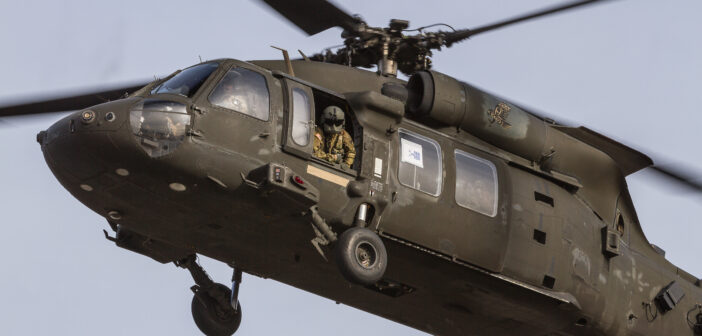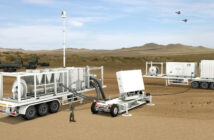– By John Haystead –
As with all things EW, aircraft self-protection has always been an ever-continuing, cat-and-mouse game between warning and countermeasure system developers and constantly improving weapon systems. But, today, the challenge is exponentially more complex because it is not just improvements in one weapon system that must be addressed, but the number of threats and threat types that must be dealt with, particularly those faced by rotorcraft and small fixed-wing platforms. Today, these threats include not only sophisticated radar, IR, and laser-guided missiles, redundant combinations of the technologies, but also prolific numbers of man-portable guided weapons (MANPADS) as well as basic, but still potentially deadly, human-directed hostile fire.
That’s the situation faced by the Army in providing effective self-protection capabilities for its helicopters and light aircraft. And, it’s a situation they realize cannot be addressed in one fell swoop, but instead requires both a new short-term interim capability, followed by a much more capable and comprehensive capability for the long term.
In June of last year, the Army released a request for information (RFI) for the long-term solution – the Advanced Threat Detection System (ATDS) to provide missile warning, hostile fire indication (HFI), and laser warning capability for its fleet of rotary wing and fixed wing aircraft. For ATDS, the Army is seeking current technologies at a minimum demonstrated Technology Readiness Level (TRL) 6. An RFP is expected in the 2020 timeframe with a planned First Unit Equipped (FUE) date of FY2023.
For the shorter-term, the Army released a request for proposals (RFP) last month for the Limited Interim Missile Warning System (LIMWS). An upgrade of the existing AAR-57 Common Missile Warning System (CMWS), LIMWS is described as a missile warning system with Hostile Fire Indication (HFI) capabilities that can be integrated with the Common Infrared Countermeasure (CIRCM) system and the ALE-47 countermeasure dispensing system for a limited number of Army UH-60M helicopters. (See JED, May 2017, p. 15, for more.) The RFP calls for engineering 9 A-kit prototypes and 30 LIMWS prototypes, followed by initial production of 36 systems and follow-on production of up to 400 systems. Among the LIMWS requirements are: “a measurable System Probability of Cueing (Pcue) performance, Probability of Declaration (Pd) performance, Probability of Declaration in Clutter (Pdic) performance, False Alarm Rates ((FAR) resulting in a flare dispense) and False Cue rate (resulting in a laser CM response).”
BAE Systems Electronic Systems (Nashua, NH) is one company with definite plans to compete for both programs and, toward that end, has announced a new threat warning system suite designed to increase aircraft survivability from advanced threats. BAE Systems currently provides the CMWS as well as the AN/ALQ-212 Advanced Threat Infrared Countermeasures (ATIRCM) system. The company’s new 3-Dimensional Advanced Warning System, or 3DAWS, is designed to provide much-improved certainty of threat recognition vs. false alarms and allow the suite to make a definitive threat assessment before directing the appropriate countermeasure.
At the core of the 3DAWS suite is a passively-cued, semi-active RF 3D-tracker, working in conjunction with the aircraft’s passive missile warning system, such as CMWS, as well as its countermeasure dispenser. As described by Cheryl Paradis, BAE Systems’ Director of Threat Management Solutions, once cued, the radar-based sensor is automatically activated and directed toward the potential threat. It can then very quickly determine whether or not it’s coming toward the aircraft and, therefore, conclusively a threat. “It provides a third dimension. While the passive warning system gives you azimuth and elevation information, the 3-D tracker gives you the range as well. You can then confidently cue your countermeasure system even if you’ve never seen that particular threat before – the first-encounter scenario.” The 3 DAWS integrates with the ATIRCM and Common Infrared Countermeasures (CIRCM) systems, the ALE-47 countermeasure dispensing system, the ALQ-211 Suite of Integrated Radio Frequency Countermeasures (SIRFC), the APR-39 radar warning receiver, and the AVR-2B laser detection set. The company also recently partnered with Leonardo DRS Technologies (Arlington, VA) on its 2-color IR technology to provide an improved version of CMWS – the 2-color IR CMWS. The CMWS-2CIR will form part of the company’s offering for LIMWS along with its enhanced threat detection algorithms and machine learning technology.
As observed by Paradis, “With the vast array of different threats, the requirement has become to be able to detect everything that looks like a threat and then defeat it. The Army today is worried about the threat proliferation, threat changes, and signature changes, and they want to be able to know more conclusively if something they see is a threat. The hard part of that is, if you can detect everything, using whatever band, UV or IR, then you need to have a way to be able to say definitively say that that thing I see is a threat, and I better get on to defeating it.”
Added to this challenge is the ability of threat systems to rapidly alter their identifying characteristics. Says Paradis, “As missiles – and specifically MANPADS – get more sophisticated in the digital age, it’s not the same war that we fought in the past where we could easily recognize a missile when we saw it, exploit it, and figure out everything we needed to know about how to defeat it. Today, the timescale for making changes to those missiles is radically different, potentially instantaneous, and suddenly you’re faced with something new on the scene that you haven’t seen before. This is where machine-learning algorithms can be brought to bear, and we’ve been investing significantly in being able to bring the dynamics associated with machine-learning to missile warning in addition to other applications.”
To be sure, the LMIWS program may attract other bidders, such as Northrop Grumman or Elbit Systems of America. Northrop Grumman is supplying compact missile warning systems for various special operations aircraft, and Elbit Systems North America can draw on the Passive Airborne Warning System (PAWS) family. ♦
If you enjoyed this article, please share. If you would like to read more articles like this one, we encourage you to join the AOC to receive a copy of JED every month.







